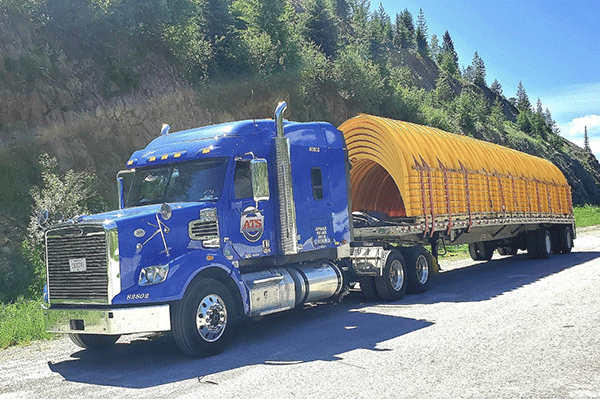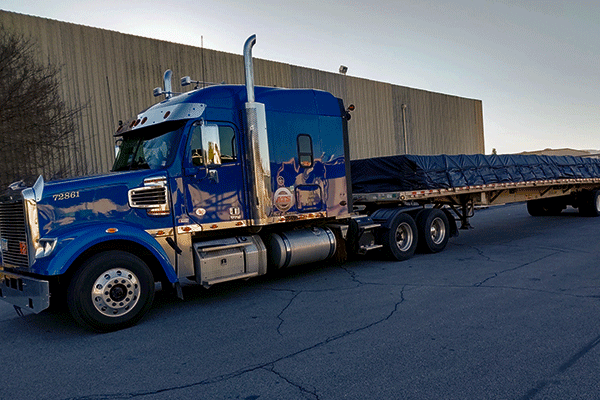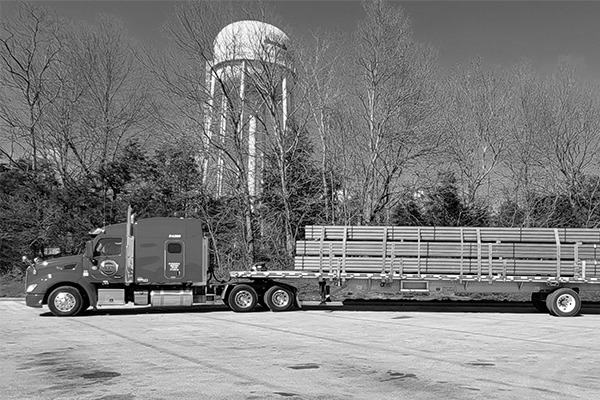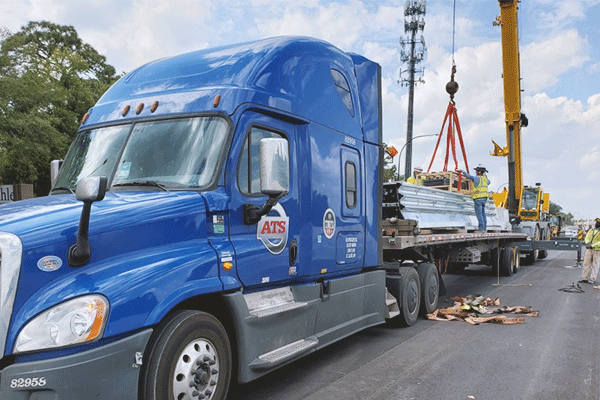- Flatbed trailer dimensions
- Overhanging freight on a 48-foot flatbed trailer
- Overhanging freight on a 53-foot flatbed trailer
- Front overhang on a flatbed trailer
- End-to-end loading and overhang on a flatbed
The total freight length you’re legally allowed to transport using a flatbed trailer changes from one state to the next. Each state government has very specific guidelines outlining what dimensions shippers can and cannot haul on a flatbed trailer without permitting.
If your company consistently ships goods across state lines, you’ve likely noticed the discrepancies in the total amount of overhang you’re allowed in each. Needless to say, this can get confusing and, without grasping the intricacies of legal flatbed overhang, costly delays occur frequently.
As such, the more you can do to understand how much front and rear overhang is allowed on your flatbed loads (and how this changes when freight is legally divisible), the better off you’ll be going forward.
Here at ATS, we firmly understand the rules that dictate how much overhang is allowed on flatbed trailers in each state. Successfully transporting open-deck freight is one of our core service offerings and we’ve become something of an expert in doing so.
That said, it’s not uncommon for shippers to ask us whether they can overhang freight on a flatbed trailer. Honestly, though, the truthful answer is “it depends.”
In this article, we’ll give you an understanding of why it depends and what you can do to prepare for your next shipment. Let's get started!
What Are the Dimensions of a Flatbed Trailer?
The most common flatbed trailer dimensions are 48- or 53-feet long with a deck measuring 8 feet, 6 inches wide.
Flatbed trailers — one of the most frequently utilized trailer types on America’s roads — come in various lengths. That said, the 48 and 53-foot versions are the most commonly employed.
Resting 5 feet off of the ground, these trailers are used nationwide to move freight that fits on their 8 foot, 6 inch-wide deck and measures under 8 feet, 6 inches in total height.
Since these trailers have a fairly specific set of capabilities — and other open-deck trailer types are available— a load’s dimensions factor greatly into whether a flatbed will fit the bill.
Freight height is a good example of this.
What is The Legal Height For a Flatbed Load?
Any load that exceeds 8 feet, 6 inches in height can’t legally be hauled on a flatbed trailer. To do so would require permitting, and in most cases — since a step-deck trailer is able to move taller freight — this isn’t cost-effective.

As such, the legal dimensions for height (8’6”), weight (48,000 pounds) and width (8’6”) of the flatbed trailer leave very little room for interpretation. And, for the most part, freight that exceeds these thresholds will need to find another option. Whether this is done by utilizing oversized/overweight permits or using another type of trailer depends on your situation.
Where front and rear overhang is concerned, though, the guidelines for flatbed trailers get a bit fuzzier due to their varying lengths.
From each state to the next, the guidelines for legal flatbed overhang fluctuate substantially. Let’s talk about them.
Can You Overhang Freight on a 48-Foot Flatbed Trailer?
Typically, it is legal to overhang freight on a 48-foot flatbed trailer without permitting — up to a certain point.
You see, many states base their permitting requirements on the total length of the flatbed, coupled with that of its freight.
And, starting just behind the kingpin, states like Indiana, Missouri, Mississippi and Washington rule that the total length of a load and trailer cannot exceed 53 feet.
For shipments moved on a 48-foot trailer, this leaves roughly five additional feet of “free” rear overhang — given the freight is “self-supporting” — in the states that allow it. Anything beyond this five additional feet — and 53 feet total— will, most likely, require an oversized permit.

Other states, however, limit rear freight overhang on a flatbed trailer to under four feet regardless of whether the total load and trailer length is 53 feet. Any freight over this length in these states will require permitting — unless it qualifies for permitting exceptions.
For example, Texas is one of the states that normally limits total open-deck overhang to less than four feet. That said, there are several products — like steel and pipe — that are an exception to this rule. This is mostly due to the frequency with which these products are moved throughout Texas and this exception isn’t carried across state lines.
Special rules like this for flatbed trailers exist from state to state. For instance, Rhode Island and West Virginia allow six feet of rear overhang while New Mexico allows seven.
As such, it’s important that you work with your transportation provider to figure out your overhang leeway based on the location and route of your shipment.
In many cases, you won’t need a 53-foot trailer for your 52-foot load because yes, you can legally overhang freight on a 48-foot flatbed trailer.
Can You Overhang Freight On a 53-Foot Flatbed Trailer?
In general, it is not legal to overhang freight on a 53-foot flatbed trailer without a permit. Typically, when the total load and trailer length exceeds 53 feet or the total tractor, trailer and load length exceed 65 feet end to end, permitting is required.
Wisconsin, for example, only allows total end-to-end length (tractor, trailer and load) to reach 65 feet before permitting is necessary.
There are, however, states that present an exception to this rule.
Wyoming is one such outlier. In the cowboy state, as long as the total trailer and load length don’t exceed 60 feet, permitting isn’t required, making overhang on a 53-foot flatbed trailer legal.
So, as long as your load is self-supporting, properly loaded and marked with flags, permitting shouldn’t be necessary in Wyoming for loads of overhang lengths within this range.
That said, states like Wyoming are far from the norm. You shouldn’t expect to rear overhang on a 53-foot flatbed without permitting.
Since there is so much nuance to this discussion, though, make sure to work with your transportation provider to figure out whether, based on your freight’s route, overhang is probable.
Can I Front Overhang on a Flatbed Trailer?
It depends, but in many instances, you can legally overhang on the front of a flatbed trailer.
Each state in our nation also has its own set of guidelines dictating the total amount of front overhang permitted on flatbed loads.
Like overhanging off the back of a flatbed, these regulations vary greatly from one state to another.
In Kentucky and Louisiana for instance, no amount of front overhang is allowed without oversized permitting. Illinois and South Dakota on the other hand legally allow up to three and four feet of front overhang, respectively.
That said, the allotted amount of front overhang for your flatbed freight isn’t solely legally limited. You see, many semi-tractors have what is known as a “headache rack” attached to their rear.
As an added barrier, these headache racks are designed to keep drivers safe from shifting cargo during transportation and usually come equipped with a fair amount of storage space to boot.
Although headache racks are an excellent tool with many benefits, they present a physical barrier impacting your ability to overhang freight from the front of a trailer.
As such, even if you’re looking to move goods across Michigan — a state that allows up to three feet of front overhang (granted no other over-dimensions exist) — if the tractor hauling your load has a headache rack, you may simply run out of room.
For this reason, be sure to coordinate with your transportation provider. Information on the exact nature of your load including its dimensions, origin and destination will help them find the best fit truck and trailer for your needs.
Can I Load End to End and Have Legal Overhang?
The rules for loading multiple pieces of material end to end aren't consistent across states, so it's best to look up the specific rules for the states on your freight's route.
Some states allow end-to-end loaded front overhang up to a certain point while others don’t. Certain states let shippers load end to end and legally overhang from the back of their flatbed, more don’t.
Although there is massive fluctuation from each state to the next, where end-to-end overhang is concerned, here are a couple of general rules of thumb:
1. If your freight is loaded end to end, legal rear overhang is likely — especially on 48-foot trailers. Most states (a little over half of them) will allow rear overhang on end-to-end flatbed loads up to a certain point.-
- Examples include:
- Georgia -- As long as load and trailer length doesn’t exceed 53 feet.
- South Dakota -- Yes, up to four feet.
- Massachusetts -- No.
- Minnesota -- No.
- Examples include:
-
- Examples include:
- Alabama -- Yes, up to 10 feet.
- Idaho -- Yes, up to 4 feet.
- Indiana -- Yes, as long as total load and trailer length doesn’t exceed 53 feet.
- Nebraska -- No.
- North Carolina -- No.
- Examples include:
A little over 30 states allow legal rear and front overhang for freight that’s loaded end-to-end.
The others either don’t allow any overhang in these scenarios or require oversized permitting for loads that are divisible.
Related: Divisible and Non-Divisible Loads Explained (Differences, Exceptions and Rules)
The right transportation provider, with a reliable history of moving overly long freight, will be able to help you figure out your own permitting requirements.

Find The Transportation Provider You Deserve
Now that you understand how intricate this process can be, you know how important it is to have a competent provider in your corner. A provider with the expertise and experience you need to make the most of your oversized flatbed shipping journey.
That said, choosing the right provider is far from simple. And, too often shippers are left at a disadvantage where this is concerned. Check out this article which outlines five essential keys to choosing the best flatbed carrier for your business.
Keep these tactics in mind as you work to fine-tune your supply chain and prioritize quality service and reliability.
Here at ATS, we take pride in offering top-of-the-line transportation services to the customers we work with. Where flatbed shipping and oversized permitting is concerned, we have the highest level of expertise. So please don’t hesitate to reach out to us with any questions you may have. Moving more complex freight can get complicated, let us simplify it for you.





